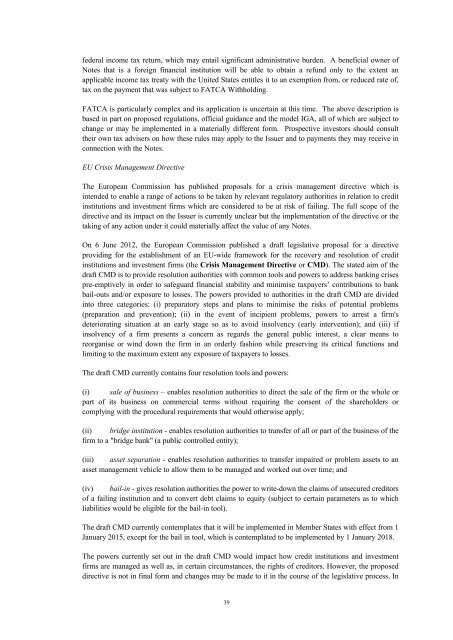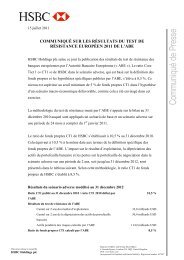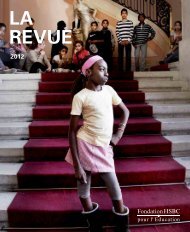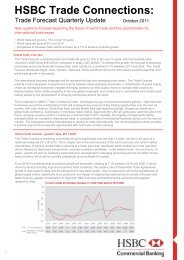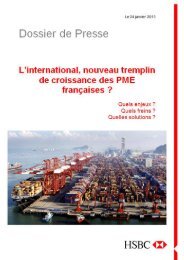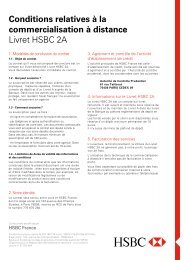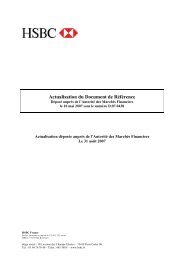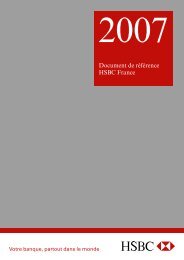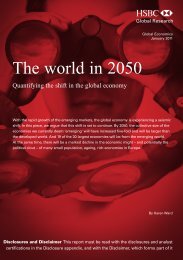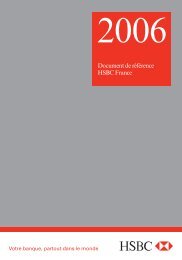any <strong>Note</strong> as a result of the imposition of such withholding tax. If a withholding tax is imposed onpayment made by a paying agent, the Issuer will be required to maintain a paying agent in a MemberState that will not be obliged to withhold or deduct tax pursuant to the Savings Directive.The <strong>Euro</strong>pean Commission has proposed certain amendments to the Savings Directive which may, ifimplemented, amend or broaden the scope of the requirements described above.Investors who are in any doubt as to their position should consult their professional advisers.U.S. Foreign Account Tax Compliance Withholding may affect payments on the <strong>Note</strong>sSections 1471 through 1474 of the U.S. Internal Revenue Code (FATCA) impose a new reportingregime and potentially a 30% withholding tax with respect to certain payments to any non-U.S.financial institution (a "foreign financial institution", or "FFI" (as defined by FATCA)) that (i) does notbecome a "Participating FFI" by entering into an agreement with the U.S. Internal Revenue Service(IRS) to provide the IRS certain information in respect of its account holders or (ii) is not otherwiseexempt from or in deemed-compliance with FATCA. The new withholding regime will be phased inbeginning in <strong>20</strong>14 for payments received from sources within the United States and will apply to"foreign passthru payments" (a term not yet defined) no earlier than <strong>20</strong>17. This withholding wouldapply to (i) any <strong>Note</strong>s characterized as debt (or which are not otherwise characterized as equity andhave a fixed term) for U.S. federal tax purposes that are not yet outstanding as of the date (the"grandfathering date") that is six months after the date on which final U.S. Treasury regulationsdefine the term "foreign passthru payments" or are materially modified after the grandfathering dateand (ii) any <strong>Note</strong>s characterized as equity or which do not have a fixed term for U.S. federal taxpurposes, whenever issued. If <strong>Note</strong>s are issued before the grandfathering date, and additional <strong>Note</strong>s ofthe same series are issued on or after that date, the additional <strong>Note</strong>s may not be treated as exempt fromFATCA Withholding, which may have negative consequences for the existing <strong>Note</strong>s, including anegative impact on market price.The United States and a number of potential partner countries have announced their intention to enterinto intergovernmental agreements to facilitate the implementation of FATCA (each, an IGA), andafter consultation with these countries, the United States released a model IGA. Pursuant to FATCAand the model IGA, an FFI in an IGA signatory country could also be treated as a "Reporting FI" notsubject to FATCA withholding on any payments it receives. Such an FFI would also not be required towithhold under FATCA or an IGA (or any law implementing or complying with, or introduced in orderto conform to an IGA) (FATCA Withholding) from payments it makes, but the model IGA leavesopen the possibility that such an FFI might in the future be required to withhold on foreign passthrupayments that it makes. A Reporting FFI would be required to report certain information in respect ofits account holders to its home government.If the Issuer becomes a Participating FFI under FATCA or a Reporting FI pursuant to an IGA, theIssuer and financial institutions through which payments on the <strong>Note</strong>s are made may be required towithhold FATCA Withholding if (a) any FFI through or to which payment on such <strong>Note</strong>s is made isnot a Participating FFI, a Reporting FI, or otherwise exempt from or in deemed-compliance withFATCA or (b) an investor (other than an exempt investor) does not provide information sufficient todetermine whether the investor is a U.S. person or should otherwise be treated as holding a "UnitedStates Account".If an amount in respect of FATCA Withholding were to be deducted or withheld from interest,principal or other payments on the <strong>Note</strong>s, neither the Issuer nor any paying agent nor any other personwould, pursuant to the conditions of the <strong>Note</strong>s, be required to pay additional amounts as a result of thededuction or withholding of such tax. As a result, investors may receive less interest or principal thanexpected. If any FATCA Withholding is imposed, a beneficial owner of <strong>Note</strong>s that is not a foreignfinancial institution generally will be entitled to a refund of any amounts withheld by filing a U.S.38
federal income tax return, which may entail significant administrative burden. A beneficial owner of<strong>Note</strong>s that is a foreign financial institution will be able to obtain a refund only to the extent anapplicable income tax treaty with the United States entitles it to an exemption from, or reduced rate of,tax on the payment that was subject to FATCA Withholding.FATCA is particularly complex and its application is uncertain at this time. The above description isbased in part on proposed regulations, official guidance and the model IGA, all of which are subject tochange or may be implemented in a materially different form. Prospective investors should consulttheir own tax advisers on how these rules may apply to the Issuer and to payments they may receive inconnection with the <strong>Note</strong>s.EU Crisis Management DirectiveThe <strong>Euro</strong>pean Commission has published proposals for a crisis management directive which isintended to enable a range of actions to be taken by relevant regulatory authorities in relation to creditinstitutions and investment firms which are considered to be at risk of failing. The full scope of thedirective and its impact on the Issuer is currently unclear but the implementation of the directive or thetaking of any action under it could materially affect the value of any <strong>Note</strong>s.On 6 June <strong>20</strong>12, the <strong>Euro</strong>pean Commission published a draft legislative proposal for a directiveproviding for the establishment of an EU-wide framework for the recovery and resolution of creditinstitutions and investment firms (the Crisis Management Directive or CMD). The stated aim of thedraft CMD is to provide resolution authorities with common tools and powers to address banking crisespre-emptively in order to safeguard financial stability and minimise taxpayers’ contributions to bankbail-outs and/or exposure to losses. The powers provided to authorities in the draft CMD are dividedinto three categories: (i) preparatory steps and plans to minimise the risks of potential problems(preparation and prevention); (ii) in the event of incipient problems, powers to arrest a firm'sdeteriorating situation at an early stage so as to avoid insolvency (early intervention); and (iii) ifinsolvency of a firm presents a concern as regards the general public interest, a clear means toreorganise or wind down the firm in an orderly fashion while preserving its critical functions andlimiting to the maximum extent any exposure of taxpayers to losses.The draft CMD currently contains four resolution tools and powers:(i) sale of business – enables resolution authorities to direct the sale of the firm or the whole orpart of its business on commercial terms without requiring the consent of the shareholders orcomplying with the procedural requirements that would otherwise apply;(ii) bridge institution - enables resolution authorities to transfer of all or part of the business of thefirm to a "bridge bank" (a public controlled entity);(iii) asset separation - enables resolution authorities to transfer impaired or problem assets to anasset management vehicle to allow them to be managed and worked out over time; and(iv) bail-in - gives resolution authorities the power to write-down the claims of unsecured creditorsof a failing institution and to convert debt claims to equity (subject to certain parameters as to whichliabilities would be eligible for the bail-in tool).The draft CMD currently contemplates that it will be implemented in Member States with effect from 1January <strong>20</strong>15, except for the bail in tool, which is contemplated to be implemented by 1 January <strong>20</strong>18.The powers currently set out in the draft CMD would impact how credit institutions and investmentfirms are managed as well as, in certain circumstances, the rights of creditors. However, the proposeddirective is not in final form and changes may be made to it in the course of the legislative process. In39
- Page 1 and 2: Base Prospectus dated 14 December 2
- Page 3 and 4: The Arranger and the Dealers have n
- Page 5: Other than as set out above, neithe
- Page 8 and 9: actions of any Authorised Offeror,
- Page 10 and 11: Notes 30 June 2012 30 June 2011(in
- Page 12 and 13: Global Asset Management is recognis
- Page 14 and 15: effected directly or via their resp
- Page 16 and 17: specifies “Contractual Masse”,
- Page 18 and 19: continuity of such market if one de
- Page 20 and 21: RESUME EN FRANÇAIS DU PROGRAMMELes
- Page 22 and 23: au sein duGroupeB.9 Prévision oues
- Page 24 and 25: à l’Emetteurprésentant unintér
- Page 26 and 27: titre du Règlement (CE) N° 1060/2
- Page 28 and 29: C.9 Intérêts,échéance etmodalit
- Page 30 and 31: · Le risque de liquidité : se dé
- Page 32 and 33: E.2bRaisons del’offre etutilisati
- Page 34 and 35: 2. Risks related to the structure o
- Page 36 and 37: The European Commission intends in
- Page 40 and 41: addition, certain proposals contain
- Page 42 and 43: Government and monetary authorities
- Page 44 and 45: DOCUMENTS INCORPORATED BY REFERENCE
- Page 46 and 47: INFORMATION INCORPORATED BY REFEREN
- Page 48 and 49: SUPPLEMENT TO THE BASE PROSPECTUSIf
- Page 50 and 51: interest, if any, payable thereunde
- Page 52 and 53: (i)(ii)(iii)on the same basis as th
- Page 54 and 55: circumstances in which the Notes wi
- Page 56 and 57: Noteholder or in fully registered f
- Page 58 and 59: accordance with Condition 15. Any b
- Page 60 and 61: For the purposes of these Condition
- Page 62 and 63: The fraction is:If dd2 = 31and dd1
- Page 64 and 65: Interest Period Date means each Int
- Page 66 and 67: For the purposes of this sub-paragr
- Page 68 and 69: Date shall be the Early Redemption
- Page 70 and 71: Redemption Amount to be notified to
- Page 72 and 73: To exercise such option or any othe
- Page 74 and 75: (g)CancellationAll Notes purchased
- Page 76 and 77: (including Luxembourg so long as th
- Page 78 and 79: 2000 on the taxation of savings inc
- Page 80 and 81: The Masse alone, to the exclusion o
- Page 82 and 83: In accordance with Article R.228-71
- Page 84 and 85: (c)Any notice given by publication
- Page 86: RECENT DEVELOPMENTSOn 11 December 2
- Page 89 and 90:
In the case of Materialised Notes w
- Page 91 and 92:
a bank account opened in a financia
- Page 93 and 94:
CorporationsThere is no withholding
- Page 95 and 96:
2012 [and the supplement[s] to the
- Page 97 and 98:
(ii) Interest Payment Date(s): [•
- Page 99 and 100:
(ii) Day Count Fraction: [Actual/Ac
- Page 101 and 102:
Masse) applies, insert below detail
- Page 103 and 104:
PART B - OTHER INFORMATION1. LISTIN
- Page 105 and 106:
5. Fixed Rate Notes only - YIELD[No
- Page 107 and 108:
the public the amount of the offer:
- Page 109 and 110:
[ANNEX -ISSUE SPECIFIC SUMMARY][ins
- Page 111 and 112:
SUBSCRIPTION AND SALESubject to the
- Page 113 and 114:
of the Issuer of any of its content
- Page 115 and 116:
For the purposes of this provision,
- Page 117 and 118:
AndorraAny investor purchasing the
- Page 119 and 120:
france/entreprises-institutionnels/


